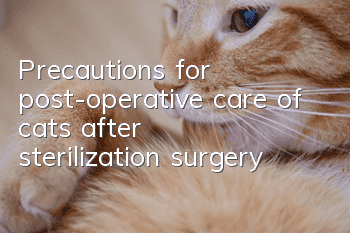Precautions for post-operative care of cats after sterilization surgery

Parents who raise cats generally encounter the problem of cat sterilization. Of course, the necessity and importance of cat sterilization need not be discussed. However, cat sterilization surgery will seriously damage the cat's vitality, so parents must take careful care after the surgery. cat, and try to help the cat recover as soon as possible.
Post-operative care for cats after sterilization surgery:
1. Taking the cat home: Do not try to take over the cat that has just been operated on from the veterinarian. They are specially trained in the way they hold cats. All you have to do is open the prepared box and let the veterinarian lay the cat flat. Gently cover the cat with a small quilt. Pay attention to keeping your head out of the way to keep the cat breathing smoothly.
2. Give the cat eye drops promptly, one drop every 2 minutes or so, or extend/shorten the interval depending on the dryness of the cat’s eyeballs.
3. If you are willing, you can check the cat’s mouth, pull out the cat’s tongue, and dry the mucus in the mouth. This can keep the cat’s mouth half-open to facilitate breathing.
4. You can also put a small piece of folded towel under the cat's shoulders and let the cat's head hang down slightly. This can prevent the mucus (or vomit) in the cat's mouth from flowing into the throat and hindering breathing. This position is called the recovery position.
5. You can gently hold the cat's paws with your hands. Her paws will be very cold at this time.
6. Be sure to avoid bumping, shaking and moving the cat without authorization, and try to let the cat sleep for a while under the control of anesthesia. Because after waking up, it will be very painful. (Do not give a resuscitation injection) 7. During the cat's anesthesia, you can cut his nails (applicable to domestic cats), and you can also have the doctor check his ears to see if there are ear mites. Generally, the ears of stray cats will be dirty and can be wiped clean with a cotton swab.
From surgery to recovery: This stage lasts about 3-5 hours. Depending on the cat’s physical condition, cats in good health will wake up faster. Some cats wake up within an hour after surgery, while others sleep for a full day. What we can do when the cat is sleeping:
1. Place the cat’s box in a quiet and warm place. Never place it in a high place to avoid direct sunlight. Stay by your side and don't leave.
2. Instill eye drops every few minutes, and wipe the eye drops that flow out with cotton wool.
3. Pay attention to the cat’s breathing, pulse, and body temperature. In the event of serious abnormalities, contact the veterinary hospital promptly. (Cat’s pulse: 160-240 beats/minute, body temperature: 38-39, respiration: 20-30 times/minute) If you find that your cat is breathing rapidly and wheezing (as if there is phlegm in the throat), you must contact the hospital immediately. It is recommended that the cat wakes up in the hospital (at least he can lie up on his own and his head canLift it up) before leaving the hospital.
4. Pay attention to heat preservation. If it is a low temperature season, you can put a hot water bag in the cat's box. Pay attention to keeping the room ventilated and dry, but be sure to avoid wind blowing directly on the cat.
- Do cats also like to fight? What are the reasons why domestic cats fight?
- Why do cats like cardboard boxes?
- Summer is coming, don’t shave your cat casually
- How do you know if your cat has developed trust in people?
- It makes sense for cats to be angry. 9 major behaviors not to be committed
- Care knowledge for key color shorthair cats
- What are the precautions for cat pregnancy?
- Knowledge about the physiological structure of cat skin, what little secrets are hidden in the cat’s body?
- What causes oral ulcers in cats? How to cure oral ulcers in cats!
- How to potty train a cat



